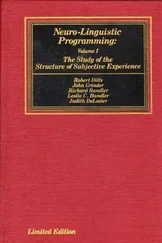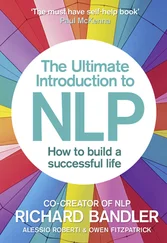That reframed the change, and preserved the signal function of the time clock. As a matter of fact, there was a productivity overrun. The employees bounced past previous efficiency levels for the next week. Then things settled down to slightly above previous levels. Business people know that if they let routines develop efficiently, then any change will probably disrupt them. However, if they very explicitly bridge or future–pace the changes to specify the way that they want them to operate, they can reduce the risk of disrupting the organization when they make changes.
Man: So is that reframing, or is it a future–pace?
It's both. You see, if you make a change without establishing an explicit frame around it, that leaves the employees to make up their own frames. So some of them might think «They've taken away my time clock, and that's just a way for them to disrupt my routine so that I don't perform my job well, because they're going to try to get rid of me.» It doesn't matter exactly what the workers hallucinate. The point is that the frames they select may be ones in which the change is considered inappropriate or disruptive. The maneuver I described recontextualized the change so that the workers could make a positive response at the appropriate time and place.
Man: For several years I worked as a lab chemist. I took off my white lab coat every Friday afternoon, and I'd have complete amnesia for anything connected with the lab until I put on my coat again the next Monday morning. As I put it on I'd ask myself «Now what was I doing Friday afternoon?»
That's a nice example. Imagine what would have happened if someone had taken away all the lab coats!
All behavior takes place in some context, and that context is the anchor for a certain set of responses. Framing is another word for contextualization, and reframing is recontextualization. Sometimes you do that by changing the actual external context. More often you change the internal context—the way a person internally frames and understands events—so as to get a different response. Whenever you do this in a system, you have to take into account how the entire system operates to be sure that the changes you make are ecological.
Reframing Dissociated States: Alcoholism, Drug Abuse, etc.
There are certain conditions that have to exist in order for six–step reframing to be effective. If you have someone who is severely dissociated, you can't expect reframing to work. Alcoholics, drug addicts, manic–depressives, and multiple personalities are all severely dissociated. Often people who overeat or smoke also fall into the same category. I'm going to talk primarily about alcoholics as an example. But I want you to understand that what I'm saying also applies to all the other examples of extreme dissociation.
If you ask the alcoholic in a sober state about his experiences while he is drunk, he will usually be partly or totally amnesic. Similarly, if you ask him while he is drunk to talk about experiences that he has when he is sober, typically he finds it difficult to offer you any information. That's one of several pieces of evidence you might use to notice that a person is dissociated: the fact that when he is operating out of one model of the world, he does not have access to experiences and resources that he has when he is operating from the other model of the world. He is a multiple personality in the sense that he has two distinct ways of operating in the world which never co–exist in his experience. The two are never in his body or his behavior at the same time.
The thing that really makes reframing work is that you develop a channel to the unconscious. By unconscious I mean the part of the person that is forcing him to do the behavior he consciously wants to change, or preventing him from doing the behavior that he consciously wants to be able to do. Reframing is a two–level communication whereby you talk with whatever part of him is conscious, and use involuntary responses to communicate with the part that is responsible for the behavior that is the focus of the change.
Typically the part of the alcoholic that brings him to your office is the sober part. That's the one who walks in. However, the sober part is already fully committed to being sober, so you don't have to do anything with that part. That's the part that already has lots of appropriate understandings about the disadvantages of drinking, but can't do anything about it. If you work with that part, you can get completely congruent responses about making changes. However, as soon as he goes into a bar, he'll be drinking again. What you need is access to the part of the person that gets him to go on binges, because that's the part of him that is running the show with respect to drinking. Since these two parts of the person are severely dissociated, while he is in one state, you cannot communicate with the other state. So when an alcoholic walks into your office in a sober state, it's extremely difficult to get access to the part that drinks, which is the part you need to change.
Most of the problems people have involve incongruity, or what is often called «conflict.» There is a mismatch, an incongruence, between the part of a person that makes him do something, and the part of the person that wants him to stop. Usually this incongruence is simultaneous: the person behaviorally expresses both parts simultaneously. For example, someone may say «I want to be assertive» in a very soft voice. The two parts are somewhat dissociated, but they express themselves at the same time.
In alcoholism or substance abuse there is a different kind of dissociation in which the incongruence is expressed sequentially over time. The sober part and the drunk part are so separate that they don't express themselves at the same time in the person's experience. They manifest themselves in sequence: first one, and later the other.
The six–step reframing format is designed to deal with simultaneous incongruity. Rather than make up an entirely different approach for sequential incongruity, you can just change a sequential incongruity into a simultaneous one, and use what you already know how to do: six–step reframing.
This kind of maneuver is common in other fields. A good mathematician will always attempt to reduce a complex problem to some other simpler problem that she already knows how to solve. If you take a difficult problem and reduce it to some other simpler problem, then you can solve it more easily.
The easiest way to change a sequential incongruity into a simultaneous one is through the use of anchoring. In the case of alcoholism, first I get access to the drunk part and anchor it. Then I anchor the sober part. Finally I collapse the two anchors in order to force the two states to co–exist.
When someone walks into your office, the sober part is right there, so that's easy to anchor. Getting access to the alcoholic part requires a bit more skill. One way to get that access is essentially to do a hypnotic induction in which you regress him to the last time he was drunk, or to some other good example of the alcoholic state, by gathering detailed sensory–grounded information from him about his experience of being alcoholic. «Go back to the last time. What do you feel like just as you are about to take the first drink? What was it like the last time you binged? Where were you sitting? What did you see? What did you hear? What did you say when you ordered the first drink? What was it? What did it look like? You can smell it now. And what exactly did it taste like? And how do you know when you are really drunk?»
If you ask your client these kinds of questions, you will see a definite shift in his behavior. As he gives you this information, he will begin to re–experience the drunk state. You'll see breathing and body posture shifts, and you'll hear a shift in the client's voice tone, tempo, and timbre qualities. You'll see a difference in facial expressions and in body movements. If you feed back those components of his experience that alter his state the most, you will amplify his experience of being alcoholic. When you see a really definitive shift, you can anchor that state.
Читать дальше











